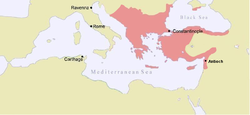Byzantium under the Komnenoi
| Roman Empire | ||||||||||
| Βασιλεία Ῥωμαίων | ||||||||||
|
||||||||||
|
The Byzantine Empire during the reign of Manuel I Komnenos, ca. 1170
|
||||||||||
| Capital | Constantinople | |||||||||
| Languages | Greek, Armenian, Old Bulgarian and other South Slavic languages | |||||||||
| Religion | Eastern Orthodox Church | |||||||||
| Government | ||||||||||
| Emperor | ||||||||||
| • | 1081–1118 | Alexios I | ||||||||
| • | 1183–1185 | Andronikos I | ||||||||
| History | ||||||||||
| • | Battle of Manzikert | 26 August 1071 | ||||||||
| • | Coronation of Alexios I | 4 April 1081 | ||||||||
| • | The First Crusade is declared | 27 November 1095 | ||||||||
| • | Battle of Myriokephalon | 17 September 1176 | ||||||||
| • | Deposition of Andronikos I | 31 August 1185 | ||||||||
|
||||||||||
The Byzantine Empire or Byzantium is a term conventionally used by historians to describe the Greek ethnic and speaking Roman Empire of the Middle Ages, centered on its capital of Constantinople. Having survived the fall of the Western Roman Empire during Late Antiquity, the Byzantine Empire continued to function until its conquest by the Ottoman Turks in 1453.
In the context of Byzantine history, the period from about 1081 to about 1185 is often known as the Komnenian or Comnenian period, after the Komnenos dynasty. Together, the five Komnenian emperors (Alexios I, John II, Manuel I, Alexios II and Andronikos I) ruled for 104 years, presiding over a sustained, though ultimately incomplete, restoration of the military, territorial, economic and political position of the Byzantine Empire.
As a human institution, Byzantium under the Komnenoi played a key role in the history of the Crusades in the Holy Land, while also exerting enormous cultural and political influence in Europe, the Near East, and the lands around the Mediterranean Sea. The Komnenian emperors, particularly John and Manuel, exerted great influence over the Crusader states of Outremer, whilst Alexios I played a key role in the course of the First Crusade, which he helped bring about.
Moreover, it was during the Komnenian period that contact between Byzantium and the 'Latin' Christian West, including the Crusader states, was at its most crucial stage. Venetian and other Italian traders became resident in Constantinople and the empire in large numbers (60–80,000 'Latins' in Constantinople alone), and their presence together with the numerous Latin mercenaries who were employed by Manuel in particular helped to spread Byzantine technology, art, literature and culture throughout the Roman Catholic west. Above all, the cultural impact of Byzantine art on the west at this period was enormous and of long lasting significance.
...
Wikipedia

